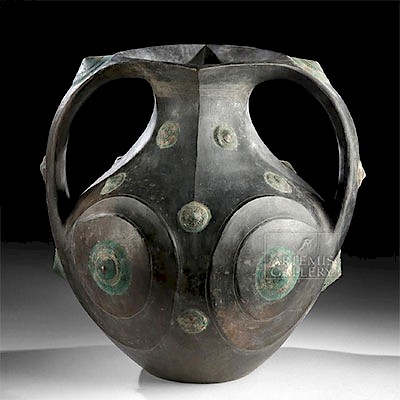Amazing Byzantine Gold Pendant - 8.5 g
Lot 91a
About Seller
Artemis Fine Arts
686 S Taylor Ave, Ste 106
Louisville, CO 80027
United States
Selling antiquities, ancient and ethnographic art online since 1993, Artemis Gallery specializes in Classical Antiquities (Egyptian, Greek, Roman, Near Eastern), Asian, Pre-Columbian, African / Tribal / Oceanographic art. Our extensive inventory includes pottery, stone, metal, wood, glass and textil...Read more
Categories
Estimate:
$3,000 - $5,000
Absentee vs Live bid
Two ways to bid:
- Leave a max absentee bid and the platform will bid on your behalf up to your maximum bid during the live auction.
- Bid live during the auction and your bids will be submitted real-time to the auctioneer.
Bid Increments
| Price | Bid Increment |
|---|---|
| $0 | $25 |
| $300 | $50 |
| $1,000 | $100 |
| $2,000 | $250 |
| $5,000 | $500 |
| $10,000 | $1,000 |
| $20,000 | $2,500 |
| $50,000 | $5,000 |
| $100,000 | $10,000 |
| $200,000 | $20,000 |
About Auction
By Artemis Fine Arts
Jul 11, 2019
Set Reminder
2019-07-11 10:00:00
2019-07-11 10:00:00
America/New_York
Bidsquare
Bidsquare : Ancient / Ethnographic / Americana
https://www.bidsquare.com/auctions/artemis-gallery/ancient-ethnographic-americana-4246
Discover ancient art from Egypt, Greece, Italy, and the Near East, as well as Asian, Pre-Columbian, Tribal, Fossils and Fine Art. Also featuring a wonderful collection from a prominent New York estate whose owners reside in the Van Wyck family's historic Lloyd Harbor waterfront home. Artemis Fine Arts info@artemisfinearts.com
Discover ancient art from Egypt, Greece, Italy, and the Near East, as well as Asian, Pre-Columbian, Tribal, Fossils and Fine Art. Also featuring a wonderful collection from a prominent New York estate whose owners reside in the Van Wyck family's historic Lloyd Harbor waterfront home. Artemis Fine Arts info@artemisfinearts.com
- Lot Description
Near East/Holy Land, Byzantine Empire, ca. 12th to 15th century CE. An incredible 89% gold pendant (equivalent to 21K+), cruciform, with curving and looping serpentine creatures extending up the upper arm, and small, eye- and head-like projections from the ends of the other three arms. A thick loop is at the top for suspension. Size: 1.55" W x 2" H (3.9 cm x 5.1 cm); 89% gold (equivalent to 21K+); 8.5 g
The Byzantine period was a time of intense religiosity and immense wealth concentrated in religion. On the backdrop of the Crusades and the split between the Eastern and Western branches of the Church, religious jewelry like this played a significant role. Not only did it symbolize one's status, it also served as a diplomatic tool. Interestingly, Emperor Justinian established laws (later called the Justinian Code) that among other things regulated the wearing of jewelry. He stated that sapphires, pearls, and emeralds were reserved for the emperor; however, every free man was actually entitled to wear a gold ring. This suggests widespread popularity of jewelry. After all, such a law would not have been necessary if jewelry had been a strictly aristocratic luxury. Indeed, wealth abounded in the Byzantine Empire. There were gold mines within its borders.
Provenance: private East Coast, USA collection; ex-Madame Frances Artuner collection, Belgium, acquired in the 1960s
All items legal to buy/sell under U.S. Statute covering cultural patrimony Code 2600, CHAPTER 14, and are guaranteed to be as described or your money back.
A Certificate of Authenticity will accompany all winning bids.
We ship worldwide and handle all shipping in-house for your convenience.
#144255Very slight bending to form and very light encrustation in lower profile areas. Excellent condition.Condition
- Shipping Info
-
All shipping is handled in-house for your convenience. Your invoice from Artemis Gallery will include shipping calculation instructions. If in doubt, please inquire BEFORE bidding for estimated shipping costs for individual items.
-
- Buyer's Premium



 EUR
EUR CAD
CAD AUD
AUD GBP
GBP MXN
MXN HKD
HKD CNY
CNY MYR
MYR SEK
SEK SGD
SGD CHF
CHF THB
THB













